IN THE CITY OF BEES
Lasioglossum malachurum is a small, inconspicuous bee.

Definitely not an insect that can catch your attention for its exceptional size, strange shape, or vivid color ...

... but when hundreds of these bees from the Halictidae family ...
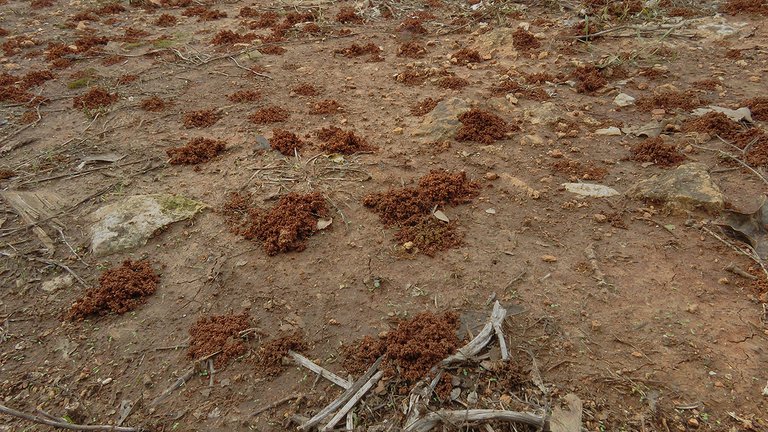
... come to nest in one place ...
... things can get pretty spectacular.
This is a post about the bees, the nesting ground ...

... and some other insects that I saw crawling around the colony in the last days of September 2022, when all these photographs were taken.
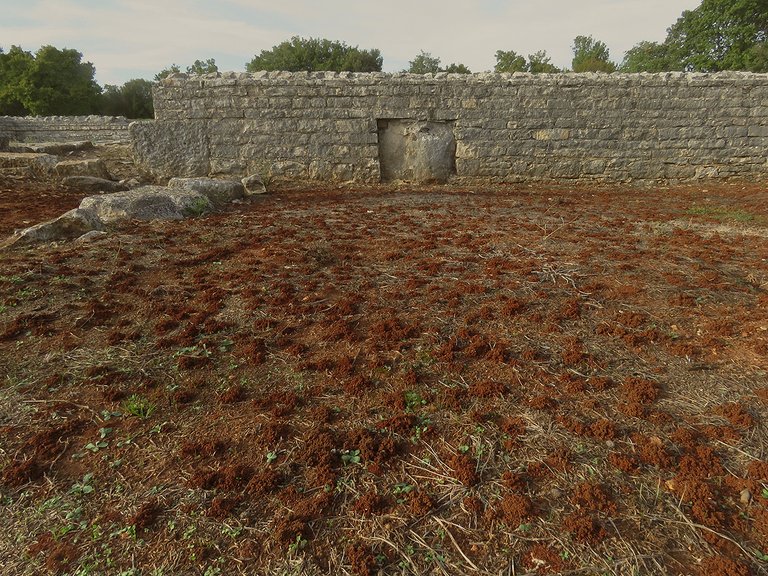
The bees have built their nests in the archeological park. Near the remains of an ancient city, that was inhabited from the Neolithic period until the 7th century.
That fact gives a new layer of meaning to the title.

Here you can see the bee standing on the pile of excavated material. The photograph was taken a second before the insect entered the hole and continued digging.
The Lasioglossum malachurum reproductive queens are hard workers that dig their way into the hard, trodden soil. Often on unpaved roads and paths. Or like in this case, in the well-kept archeological park visited by groups of tourists during the summer.
The nesting architecture is simple. A vertical tunnel that ends in a compartment made for brood, plus a few more short horizontal passages branching from the main tunnel, each ending with its brood cell.

Here you can see a leafhopper on the mound of soil excavated by the bee. Can't tell you the name of this species. The family is Cicadellidae.

I was able to take only two shots before the leafhopper jumped away. Only one of those two photographs was taken when I got close enough to show all the small details.
These piles of excavated soil form what looks like a pretty large city made of simple, repetitive architecture.
Is great to see the insect architecture intersect with an ancient urban layout created by people from the distant past.

Here you can see a bee that just started the nesting project. Not much of that typical excavated material can be seen around its workplace.
Digging the hard soil is hard and energy-expensive work, so the bees try to circumvent it by taking over another queen's nest whenever they can. Fights in the colony are quite common.

Under the ground, each cell of the nest is provisioned with a mixture of pollen and nectar in the form of a firm material that resembles dough. Getting the provisions also requires plenty of work and flying around. While the queen is visiting the flowers that grow on the lawn around the colony, there is a risk that the nest will be usurped by another bee.
Here you can see another insect that I caught crawling around the colony.

It's a weevil.
Coniocleonus nigrosuturatus from the Curculionidae family.
When the main tunnel is finished, the female starts making the brood cells connected through a short horizontal passage to that vertical backbone of the nest. When a cell is ready, excavated, and provisioned, the bee lays an egg on each bit of pollen mass. After that, the cell gets sealed ...

... and is time to make another one.

When the full-grown larvae from the earliest eggs finish pupation, the queen will have some workers to continue the work on enlarging the nest and producing more bees. These first new adults are all non-reproductive female workers, usually but not always, slightly smaller than the mother.
The reproductive female that started the nest remains in it, and now really acts as a queen while her non-reproductive daughters act as workers. The queen guards the entrance to the burrow, while the workers go out foraging for food and help in the construction of new cells, in which the queen lays new eggs.
The difference between the castes in this species isn't as defined as, for example, in the case of the honey bees. Some of the later female workers have reproductive capacity and can help breed up to two subsequent worker broods.
Males begin to emerge from the final brood of the season, followed by reproductive females that start emerging seven days later.
When it comes to the females shown in these photographs, I'm not always sure who is a worker and who is a queen. I mean, all the nests look like they were made very recently. Not exactly at the same time, but almost. In a couple of days. Since I saw some bees that have just begun building the main tunnel. I assume that these are all reproductive queens. But I could be wrong.
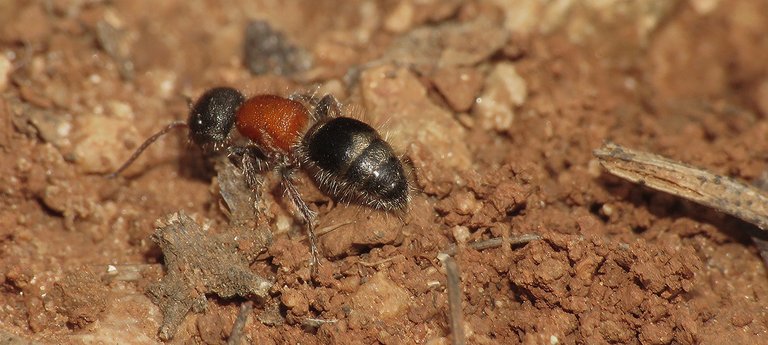
Here you can see an insect that is commonly known as a velvet ant. It looks a lot like some kind of robust ant, but this is actually a wasp.

A female wasp. The name of the species is Tropidotilla litoralis. The family is Mutillidae.

In Mutillidae, males look more like conventional wasps, while wingless females look more like ants.

It looks that the wasp shown in this series of photographs is searching for something in the colony.
Here you can see it digging into the mound created by the bee while excavating the nest.

When it comes to their reproductive behavior, these wingless wasps are parasites. So I thought that maybe this female is searching for a bee nest to parasitize on. But a few minutes ago, while writing the post, I found out that Tropidotilla litoralis parasitizes another wasp. The Paragymnomerus spiricornis.
Can't tell you what exactly the velvet ant was searching for here. Food maybe? Adults of this species feed mainly on nectar, but can occasionally be seen eating small insects and their larvae.
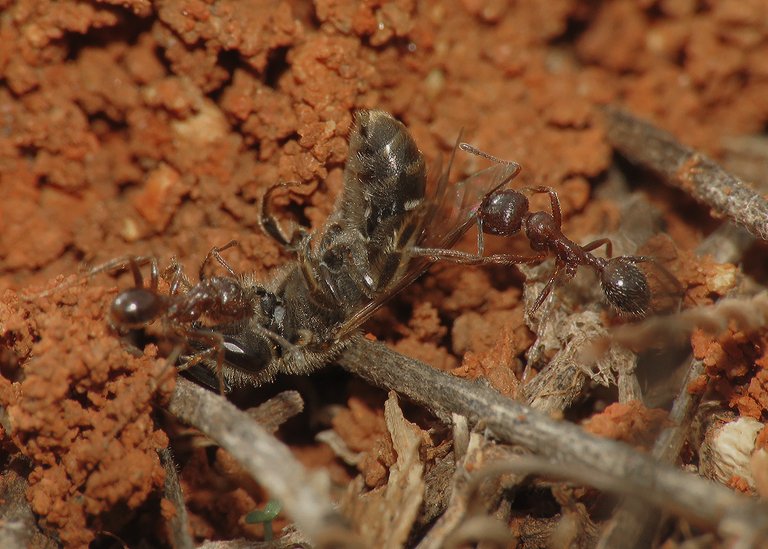
At one point, while observing the colony, I noticed some real ants ...
... that were dragging the corpse ...
... of a dead bee.

I mean, it started as a cooperative work of two ants, but soon it continued with just one of them carrying the dead bee. The scene looked almost like some kind of funeral.

The corpse will feed another underground colony.
I wasn't able to identify the ants. Can't tell you the name of the species.
Here you can see the layout of the early Christian basilica from the 5th century. Two centuries later, Nesactium - that's the name of the city, was abandoned.

Here you can see a friend who was there with me exploring some Internet stuff while I was busy around the bees.

Nesactiunm started its existence as a settlement of the people called Histri. It grew into their capital and then, after being conquered by the spreading Roman empire in 177 BC, it became a Roman fortified town that retained quite a few characteristics of the local Histri culture.
This is the Prostemma guttula.

A predatory bug from the Nabidae family.
Its presence in the colony can look like a threat to the bees at first sight, but Prostemma guttula preys exclusively on other bugs. Mainly on the nymphs and adults of the species from the Lygaeidae and the Cydnidae family that spend most of their time down on the ground.
This was a very exciting encounter because I have never seen a Prostemma guttula before or since the 29th of September 2022, when these three photographs were taken. It was a tense chase to get the bug in front of the camera because Prostemma guttula is a fast, agile runner, and in my experience, a very uncooperative model. Furthermore, I couldn't take a good shot by using the flash because the beautiful shiny surfaces of this bug's exoskeleton can be really admired only in diffused ambient light. At one point the little predator stopped for a second to clean its antennae, and I was able to get the photographs.

Here you can see the very small young nymph of some bug from the genus Deraeocoris of the Miridae family ...
... climbing the dried-out parts of some small herbaceous plant that I wasn't able to identify.
Ten to twenty centimeters from the bug, on the same kind of plant, I photographed this caterpillar. Can't tell you the name of the species but I'm pretty sure that is a moth larva.

There is one more thing I would like to say about the bees before ending the post. It's nothing scientific, just my observation from a photographer's point of view. While being very visible on the flowers, the Lasioglossum malachurum is very hard to notice down on the ground, among the fragments of dried-out vegetation. You can hear the bees buzzing all around you, but when it comes to finding one and following the action through the macro lens, it's pretty difficult.
AND THAT'S IT. IS TIME TO LEAVE THE CITY OF BEES. HOPE YOU ENJOYED YOUR STAY.
The following links will take you to the sites with more information about the protagonists and the supporting characters of this post. I found some stuff about them there.
https://en.wikipedia.org/wiki/Lasioglossum_malachurum
https://www.jungledragon.com/specie/3832/coniocleonus_nigrosuturatus.html
https://de.wikipedia.org/wiki/Tropidotilla_litoralis
https://www.britishbugs.org.uk/heteroptera/Nabidae/Prostemma_guttula.html
https://de.wikipedia.org/wiki/Prostemma_guttula
AS ALWAYS HERE ON HIVE, THE PHOTOGRAPHS ARE MY WORK.
















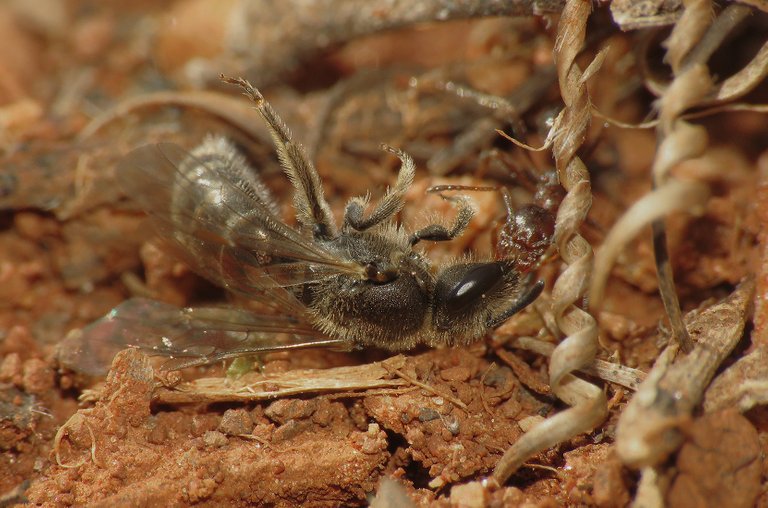







Congratulations, your post has been added to Pinmapple! 🎉🥳🍍
Did you know you have your own profile map?
And every post has their own map too!
Want to have your post on the map too?
This bee looks and feels a bit different from other bees and also you have photographed some beautiful insects that are very interesting and natural beauty of nature.
Yay! 🤗
Your content has been boosted with Ecency Points, by @borjan.
Use Ecency daily to boost your growth on platform!
Support Ecency
Vote for new Proposal
Delegate HP and earn more
It might be me but Bees are just fluffy cuddly bugs ❤️
True 😆 Bees are kinda cute.
I studied biology and my degree work was to determine the bioprotective effect of arbocular mycorrhizal fungi against stress in pea (Cajanus cajan). If I had not chosen that subject, I would have done something about reproductive biology of a plant of interest, I saw the elective and I loved it. I love Hymenoptera and have always been a fan of bees, they are so cute and important to plants. <3
Another great and amazing post by you. I have gained a lot of knowledge about insects since I started seeing and reading your post. velvet ant It hurts a lot whenever it bites. My friends are also like this, whenever I am busy at work or working on Amazon, they are sitting and enjoying social media.
Congratulations, your post has been upvoted by @dsc-r2cornell, which is the curating account for @R2cornell's Discord Community.
A lovely post as always. Since this city if bees were built on a tourist sites won't it be destroyed later on in summer or autumn?
First time I'm seeing a wingless wasp too...
Must be hard having your soulmate fly off and you have to take the low path😂😂
The bees don't mind the tourists. The underground chambers are safe. If no one excavates there, the nests are ok.
Ahhh
Real nice architectural insects then 🙂
The short word snippets together with the photos make for some engaging storytelling!
https://twitter.com/1475819111271870469/status/1615026041465995264
The rewards earned on this comment will go directly to the people( @ladytitan ) sharing the post on Twitter as long as they are registered with @poshtoken. Sign up at https://hiveposh.com.
Great to see the neolithic site still has inhabitants :D
😆
Saludos mi amigo @borjan muy ingeniosa la avispa al revisar la tierra excelentes fotos como siempre lo he dicho.
Good job.
Thanks for your contribution to the STEMsocial community. Feel free to join us on discord to get to know the rest of us!
Please consider delegating to the @stemsocial account (85% of the curation rewards are returned).
You may also include @stemsocial as a beneficiary of the rewards of this post to get a stronger support.
Waw marvelous post
That's a lot! And different colors too. They seemed inhabited in that place.
This was so very interesting to see and read about. What a huge colony that was. Different bees with different life styles, all very hard workers.
Mother Nature is certainly very clever, but that many bees in just one area does freak me out a little !LOL 🐝🐝🐝🐝
lolztoken.com
One without a spring.
Credit: reddit
@borjan, I sent you an $LOLZ on behalf of @fun.farms
Are You Ready for some $FUN? Learn about LOLZ's new FUN tribe!
(1/6)